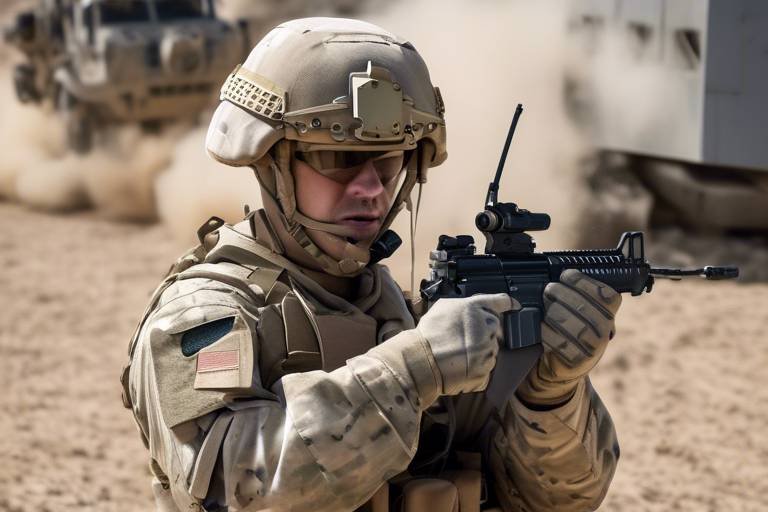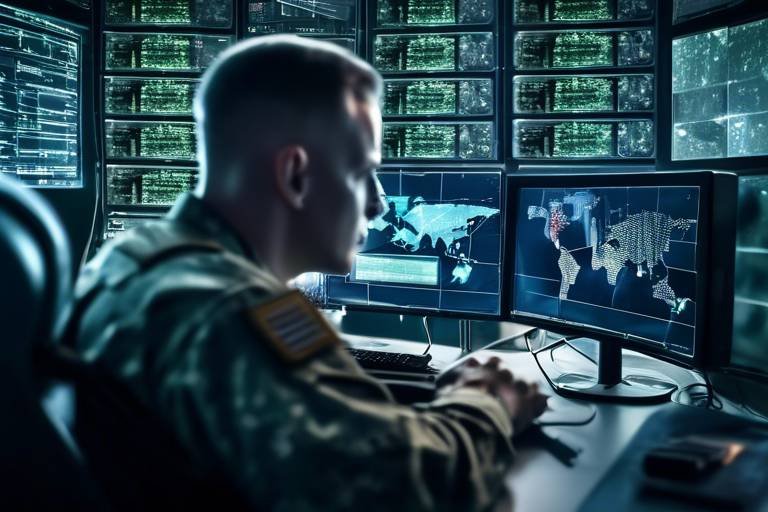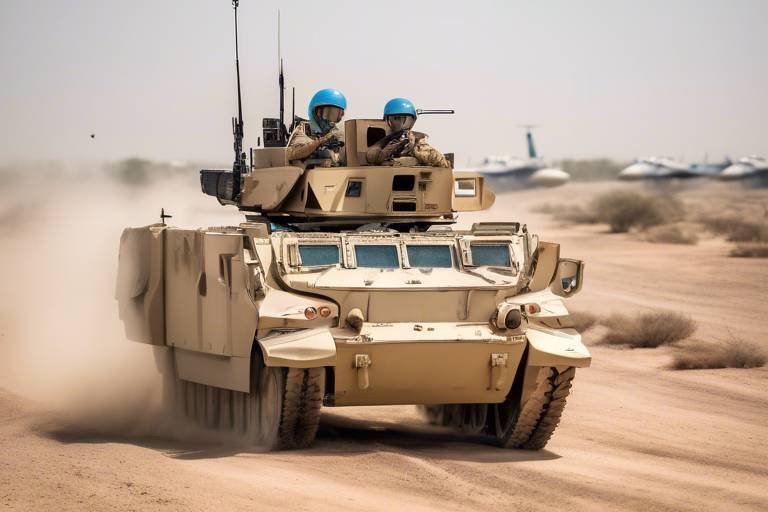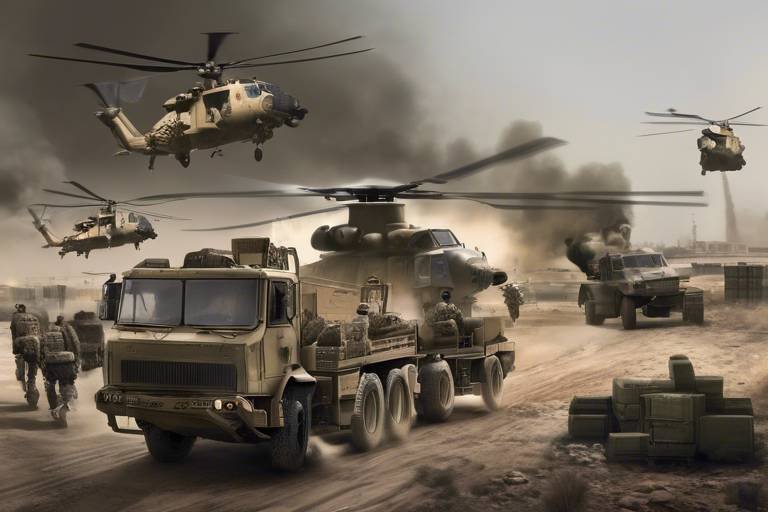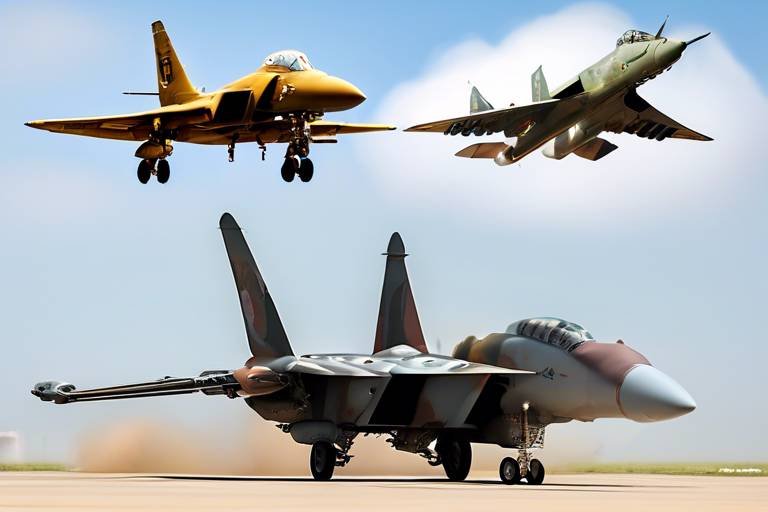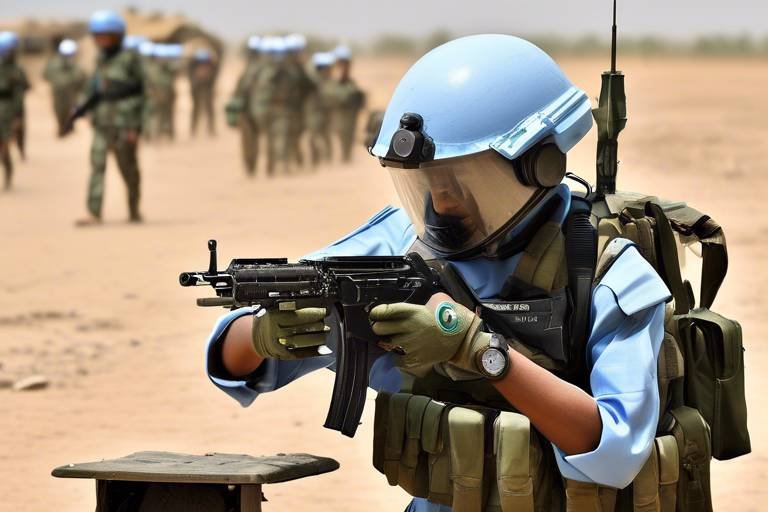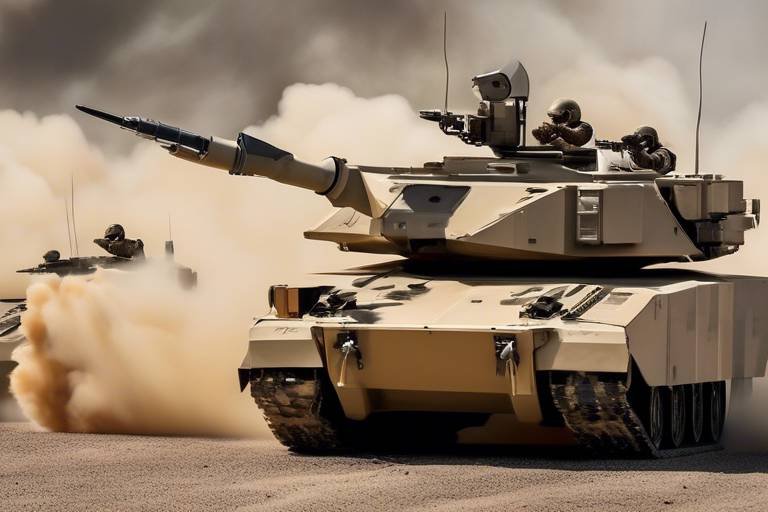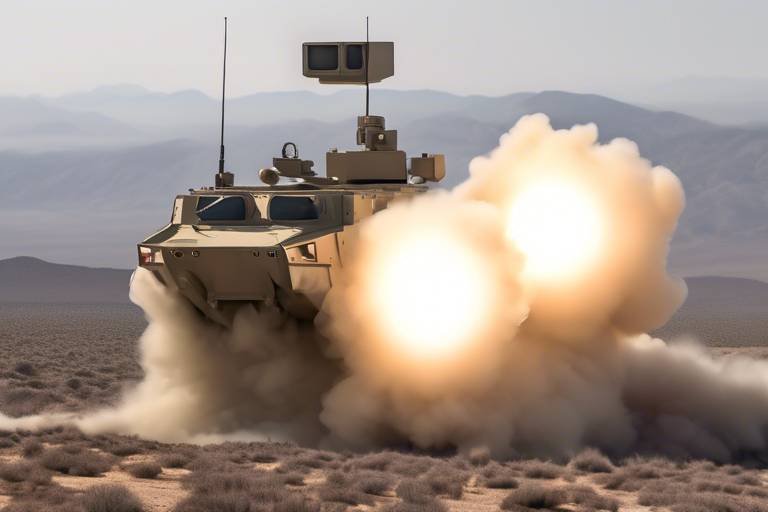The Importance of Training and Simulation in Defense Systems
In today's rapidly evolving world, the significance of training and simulation in defense systems cannot be overstated. These methodologies are not just supplementary tools; they are essential components that ensure military personnel are equipped with the necessary skills and knowledge to tackle real-world challenges. Imagine a pilot preparing for a flight in a state-of-the-art simulator, where every maneuver, every emergency scenario, and every weather condition can be practiced without leaving the ground. This is the power of simulation—it's like a dress rehearsal for the real performance, allowing for mistakes to be made in a safe environment, which ultimately leads to better preparedness.
Training and simulation create a robust framework for enhancing operational readiness. When military personnel engage in realistic training exercises, they develop critical skills that enhance their ability to respond effectively in high-pressure situations. This is not merely about physical capabilities; it encompasses mental agility, strategic thinking, and teamwork. The more realistic the training, the better the personnel can adapt to unforeseen circumstances during actual missions. It’s akin to a football team practicing plays repeatedly until they become second nature; when game day arrives, they react instinctively and cohesively.
Moreover, the cost-effectiveness of simulation technologies presents a compelling case for their integration into defense training programs. Traditional training methods often require extensive resources, including personnel, equipment, and time. In contrast, simulations can significantly reduce these expenses while maintaining high training standards. This cost-saving aspect allows defense organizations to allocate resources more efficiently, investing in advanced technologies and further enhancing their training programs.
Another critical advantage of training simulations is their ability to create realistic scenarios. These environments allow defense personnel to experience and respond to a variety of situations that they may encounter in the field. By immersing trainees in these lifelike scenarios, they can improve their decision-making skills and situational awareness. For instance, a soldier might face a simulated ambush during a training exercise, forcing them to think quickly and act decisively—skills that are invaluable during real combat situations.
As we look to the future, the integration of advanced technologies such as virtual reality and artificial intelligence into training programs is revolutionizing how defense forces prepare for operations. These technologies offer innovative methods for skill enhancement and operational strategy development, providing an immersive experience that traditional training methods simply cannot match. Imagine donning a VR headset and being transported to a battlefield where you must navigate complex terrains and engage with virtual enemies—this level of engagement can significantly bolster a trainee's confidence and competence.
Furthermore, training simulations provide immediate assessment and feedback, enabling personnel to identify their strengths and weaknesses. This instant feedback loop is crucial for targeted improvements in performance. For example, after a simulated mission, instructors can analyze the trainee's decisions, highlighting areas for improvement and reinforcing successful strategies. This process of continuous learning ensures that personnel are always evolving and adapting to meet the demands of their roles.
Collaboration and teamwork are also fostered through simulated training exercises. In defense operations, effective communication and teamwork are vital for mission success. By participating in team-based simulations, personnel learn to work together, enhancing their communication skills and building trust among team members. This is akin to a jazz band, where each musician must listen and adapt to one another to create a harmonious performance.
One of the most significant benefits of training and simulation is their adaptability to changing threats. As the landscape of global threats evolves, training programs can be rapidly adjusted to address these new challenges. This agility ensures that defense forces remain prepared for any situation, whether it be cyber warfare, unconventional combat, or humanitarian assistance missions. The ability to pivot and adapt is crucial in a world where threats can arise suddenly and unexpectedly.
Lastly, we cannot overlook the importance of psychological preparedness. Simulations not only train physical skills but also help build psychological resilience. Personnel learn to handle stress and uncertainty, which are inevitable during real-life operations. By facing simulated challenges that mimic high-stress environments, trainees develop coping mechanisms and mental fortitude, preparing them for the realities of their duties.
- What are the benefits of using simulation in defense training?
Simulation provides a safe environment for practice, reduces costs, enhances decision-making skills, and improves teamwork and communication.
- How does technology enhance training simulations?
Advanced technologies like virtual reality and artificial intelligence create immersive training experiences that replicate real-world scenarios.
- Can training simulations be adapted to new threats?
Yes, training programs can be quickly modified to address evolving threats, ensuring personnel are always prepared.

Enhancing Operational Readiness
This article explores the critical role that training and simulation play in enhancing the effectiveness and readiness of defense systems, ensuring that personnel are well-prepared for real-world challenges.
When it comes to military operations, operational readiness is not just a buzzword; it's a fundamental necessity. Imagine a firefighter who has never seen a blaze before; would you trust them to tackle a raging inferno? The same principle applies to military personnel. Training and simulation are the bedrock of preparing soldiers for the unpredictable nature of combat. These programs help develop critical skills that are essential for effective responses in high-pressure situations. Through rigorous training, personnel learn to think on their feet, make split-second decisions, and operate under extreme stress.
One of the most significant advantages of training and simulation is the ability to create controlled environments where soldiers can hone their skills without the risks associated with live exercises. For instance, during a simulated combat scenario, personnel can practice tactics, weapon handling, and teamwork. This not only boosts their confidence but also enhances their ability to execute those skills when it matters most. The emphasis on realistic training scenarios means that soldiers become accustomed to the chaos of battle, making them more adept at navigating real-world challenges.
Moreover, training simulations can be tailored to reflect specific missions or threats. This customization means that personnel can prepare for a wide range of scenarios, from urban warfare to counter-terrorism operations. As threats evolve, so too can the training programs, ensuring that soldiers are always ready to face new challenges. For example, if a new type of weapon is introduced on the battlefield, training modules can be updated swiftly to incorporate this new element, keeping soldiers at the cutting edge of operational readiness.
To further illustrate the impact of training and simulation on operational readiness, consider the following table:
| Training Method | Benefits | Impact on Readiness |
|---|---|---|
| Live Exercises | Realistic experience, team cohesion | High, but costly and risky |
| Simulation Training | Safe environment, repeatable scenarios | Very high, adaptable to threats |
| Virtual Reality Training | Immersive experiences, detailed feedback | Extremely high, enhances decision-making |
In addition to practical skills, training and simulation also focus on mental preparedness. Soldiers learn to manage their stress levels, maintain focus, and operate effectively in chaotic environments. This psychological aspect is crucial, as it allows personnel to remain calm and collected during actual missions, which can mean the difference between success and failure. Think of a high-stakes poker game; the players who can keep their cool under pressure are often the ones who walk away with the winnings. The same applies to military operations.
In conclusion, enhancing operational readiness through training and simulation is not just about learning how to use weapons or follow orders; it's about creating a comprehensive skill set that prepares military personnel for the realities of combat. By investing in advanced training programs, defense systems can ensure that their forces are not only ready to respond but are also capable of thriving in the face of adversity.
- What is operational readiness? Operational readiness refers to the ability of military forces to perform their missions effectively and efficiently.
- How does simulation training differ from live exercises? Simulation training provides a safe, controlled environment for practice, while live exercises involve real-world scenarios that can be risky and costly.
- Can training programs be adapted to new threats? Yes, training programs can be quickly updated to address evolving threats, ensuring personnel are always prepared.
- What technologies are used in modern training simulations? Technologies such as virtual reality (VR) and artificial intelligence (AI) are increasingly integrated into training simulations for enhanced experiences.

Cost-Effective Solutions
When it comes to military training, the age-old adage "you have to spend money to make money" doesn't always hold true. In fact, with the rise of simulation technologies, defense organizations are discovering that they can achieve high-quality training without breaking the bank. Imagine being able to train thousands of personnel in a fraction of the time and cost that traditional methods require. This is not just a dream; it’s becoming a reality thanks to innovative training solutions.
One of the most significant advantages of simulation-based training is its ability to reduce the costs associated with live exercises. Traditional training often involves extensive logistics, travel expenses, and the use of expensive equipment. In contrast, simulations can be conducted in controlled environments, significantly cutting down on these costs. For instance, consider the expenses related to fuel, maintenance, and wear and tear on equipment during live drills. With simulations, these costs are virtually eliminated, allowing funds to be redirected toward other critical areas.
Furthermore, simulations provide a flexible training environment that can be tailored to meet specific needs. Whether it’s a complex battlefield scenario or a straightforward tactical exercise, simulations can be adjusted on-the-fly, saving both time and resources. This adaptability means that training can be conducted more frequently and with greater focus on areas that need improvement, making the overall process more efficient.
To illustrate the cost-effectiveness of simulation training, consider the following table:
| Training Method | Cost per Participant | Duration | Logistical Needs |
|---|---|---|---|
| Live Exercises | $5,000 | 1 Week | High |
| Simulation Training | $1,500 | 1 Day | Low |
This table clearly demonstrates that simulation training is not only more affordable but also significantly less time-consuming. By investing in these technologies, defense organizations can ensure that their personnel receive the best training possible without the associated costs of traditional methods.
Moreover, the long-term savings associated with simulation training can lead to better preparedness and operational effectiveness. The money saved can be reinvested into other critical areas, such as advanced technology procurement or personnel welfare programs. This is a win-win situation: better training outcomes and optimized budget utilization.
In conclusion, the shift towards simulation technologies in defense training is not just a trend; it’s a strategic move toward creating a more efficient and cost-effective training framework. As military forces continue to evolve, embracing these innovative solutions will be essential for maintaining a competitive edge while ensuring that every dollar spent contributes to enhancing operational readiness.

Realistic Scenarios
When it comes to preparing defense personnel for real-world challenges, are absolutely essential. Imagine stepping into a virtual battlefield where every sound, movement, and decision feels strikingly real. This is where training simulations shine, creating immersive environments that mimic actual combat situations. Such realistic settings allow military personnel to not only practice their skills but also to experience the psychological pressures that come with high-stakes operations. This kind of training is akin to a pilot flying in a flight simulator before taking off in a real aircraft; it’s all about gaining confidence and competence in a safe yet challenging environment.
One of the most significant advantages of using simulations is the ability to replicate various scenarios that personnel might encounter in the field. These scenarios can range from hostage situations to natural disasters, and even cyber warfare attacks. By exposing trainees to a wide array of potential situations, they can develop critical thinking and adaptive skills. For instance, a simulation might involve:
- Responding to an ambush in an urban setting
- Conducting search and rescue operations after a natural disaster
- Managing logistics during a complex operation
Each of these scenarios provides valuable lessons that go beyond mere technical skills. They challenge individuals to think on their feet, make quick decisions, and work collaboratively with their teams. The ability to practice these scenarios repeatedly means that when the time comes for real action, the personnel involved can draw upon their training experiences, making them more effective and efficient in their roles.
Moreover, the integration of advanced technologies into these simulations, such as augmented reality (AR) and virtual reality (VR), takes realism to another level. Trainees can interact with a 3D environment that reacts dynamically to their actions, providing a more profound understanding of the consequences of their decisions. This level of immersion not only enhances learning but also helps in building muscle memory, which is crucial for quick reactions in actual situations.
In addition to improving individual performance, the use of realistic scenarios fosters a sense of teamwork and communication among defense personnel. When faced with challenges in a simulated environment, teams learn to rely on each other, enhancing their collaborative skills. This is vital because, in real missions, the ability to work as a cohesive unit can be the difference between success and failure.
In summary, the creation of realistic scenarios in training simulations is a game-changer for defense systems. By providing a safe yet challenging environment, these simulations prepare personnel not just to handle weapons and tactics but to think critically, adapt to ever-changing situations, and work effectively as part of a team. As we continue to innovate and integrate new technologies, the potential for even more realistic and effective training experiences is limitless.
Q1: How do realistic scenarios improve decision-making skills in defense personnel?
A1: Realistic scenarios expose personnel to high-pressure situations, requiring them to make quick and informed decisions. This practice helps them develop critical thinking skills that are essential in actual missions.
Q2: What technologies are used to create realistic training scenarios?
A2: Advanced technologies such as virtual reality (VR), augmented reality (AR), and artificial intelligence (AI) are commonly used to create immersive and dynamic training environments.
Q3: Can simulations replicate all types of defense operations?
A3: Yes, simulations can be designed to replicate a wide range of operations, including combat, disaster response, and logistical challenges, allowing personnel to train for various scenarios they may encounter.
Q4: How do realistic scenarios enhance teamwork among defense personnel?
A4: Simulated training exercises require personnel to communicate and collaborate effectively, fostering a sense of teamwork that is crucial for mission success in real-life operations.

Integration of Advanced Technologies
The landscape of defense training is transforming at a breathtaking pace, primarily due to the . Imagine stepping into a world where virtual reality (VR) and artificial intelligence (AI) are not just buzzwords but pivotal components of military training. These technologies are reshaping how personnel prepare for real-world challenges, making training not only more effective but also significantly more engaging.
One of the most exciting advancements is the use of virtual reality in simulations. VR creates immersive environments that mimic real-life scenarios, allowing soldiers to practice their skills in a safe yet realistic setting. For instance, a soldier can find themselves navigating a war zone, making split-second decisions while feeling the pressure of the environment. This level of realism can lead to better preparedness when facing actual threats. Furthermore, VR training can be tailored to individual needs, ensuring that each trainee gets the specific experience they require.
On the other hand, artificial intelligence is revolutionizing the way training data is analyzed. AI algorithms can process vast amounts of information in real time, providing trainers with insights into a soldier's performance that were previously impossible to obtain. This means that weaknesses can be identified and addressed almost immediately, leading to a more efficient training process. Imagine a scenario where a soldier's decision-making speed and accuracy are tracked, and instant feedback is given, allowing them to improve on the spot. This kind of adaptability is crucial in defense training.
Moreover, the combination of VR and AI can lead to the creation of adaptive training scenarios. These scenarios can evolve based on the trainee's actions, making each training session unique and challenging. For example, if a soldier excels in one area, the simulation can automatically increase the difficulty level in that aspect, ensuring continued growth and learning. This adaptability not only keeps training engaging but also ensures that personnel are always prepared for the unexpected.
To illustrate the impact of these technologies, consider the following table that outlines some key benefits:
| Technology | Benefits |
|---|---|
| Virtual Reality |
|
| Artificial Intelligence |
|
In summary, the integration of advanced technologies such as virtual reality and artificial intelligence is not just enhancing the training experience; it is fundamentally changing the way defense systems prepare their personnel. The ability to create realistic, adaptive training environments ensures that soldiers are not only learning but are also developing the skills necessary to excel in high-pressure situations. This leap forward in training methodology is a game-changer, setting a new standard for operational readiness in defense systems.
Q1: How does virtual reality improve military training?
A1: Virtual reality enhances military training by providing immersive environments that simulate real-life scenarios, allowing personnel to practice skills safely and realistically.
Q2: What role does artificial intelligence play in defense training?
A2: Artificial intelligence analyzes training data in real-time, offering immediate feedback and insights into performance, which helps in identifying areas for improvement.
Q3: Can training simulations be customized for individual needs?
A3: Yes, training simulations can be tailored to meet the specific requirements of each trainee, ensuring a more personalized and effective training experience.
Q4: What are adaptive training scenarios?
A4: Adaptive training scenarios are dynamic simulations that change based on a trainee's actions, providing unique challenges that promote continuous learning and skill enhancement.

Assessment and Feedback Mechanisms
In the realm of defense training, assessment and feedback mechanisms serve as the backbone for continuous improvement and skill enhancement. Imagine stepping into a high-stakes environment, where every decision counts, and you have the ability to analyze your performance in real-time. This is precisely what modern training simulations offer. They allow military personnel to not only practice their skills but also to receive immediate insights into their performance. This instant feedback loop is crucial; it’s like having a coach by your side during a game, providing tips and strategies to refine your approach.
One of the most significant advantages of using simulations is the ability to conduct detailed assessments post-exercise. After a training session, personnel can review their actions, decisions, and outcomes in a structured format. For example, a simulation might include a debriefing session where key metrics are evaluated. Consider the following table that outlines some of the critical assessment metrics used in training simulations:
| Assessment Metric | Description |
|---|---|
| Decision-Making Speed | How quickly personnel make critical decisions during simulations. |
| Accuracy of Actions | The precision with which personnel execute their tasks. |
| Communication Effectiveness | How well team members convey information and instructions. |
| Situational Awareness | The ability to understand and respond to the evolving environment. |
This structured feedback not only highlights areas for improvement but also reinforces positive behaviors and successful strategies. For instance, if a team consistently struggles with communication during a simulation, instructors can tailor follow-up training sessions specifically to address this issue. This targeted approach ensures that each training session is not just a routine exercise but a meaningful opportunity for growth.
Moreover, the psychological aspect of feedback cannot be overlooked. Receiving constructive criticism in a supportive environment helps personnel build resilience. It’s like learning to ride a bike; you might fall a few times, but with each attempt and feedback from a mentor, you gain confidence and skill. This psychological preparedness is essential for real-world operations, where the stakes are high, and the consequences of mistakes can be dire.
In summary, the integration of assessment and feedback mechanisms into training simulations transforms the learning experience. It provides a comprehensive framework for personnel to evaluate their performance, adapt their strategies, and ultimately enhance their operational effectiveness. This is not just about training; it's about preparing for success in the field, ensuring that when the moment of truth arrives, every team member is ready to perform at their best.
- What are the main benefits of using training simulations in defense?
Training simulations provide realistic scenarios, immediate feedback, and cost-effective solutions for enhancing operational readiness. - How do feedback mechanisms improve training outcomes?
Feedback mechanisms allow personnel to identify strengths and weaknesses, leading to targeted improvements in performance. - Can simulations adapt to new threats?
Yes, simulation programs can be rapidly updated to address evolving threats and challenges in defense operations. - What role does technology play in modern training simulations?
Advanced technologies like virtual reality and artificial intelligence are integrated into simulations to create immersive training experiences.

Collaboration and Teamwork Development
In the realm of defense operations, the importance of collaboration and teamwork cannot be overstated. These two pillars form the backbone of successful missions, where every member of the team must operate in harmony to achieve a common goal. Training and simulation exercises are designed to foster these essential skills, creating an environment where personnel can learn to work together effectively. Imagine a symphony orchestra, where each musician plays a different instrument, yet all contribute to a beautiful piece of music. Similarly, in defense scenarios, each team member brings unique skills to the table, and it is through collaboration that they can create a cohesive and effective unit.
Simulated training exercises provide a platform for personnel to engage in realistic scenarios that mimic the complexities of actual operations. During these simulations, teams must communicate clearly, strategize collectively, and make split-second decisions that can mean the difference between success and failure. For instance, during a simulated rescue mission, team members must coordinate their movements, share vital information, and support one another under pressure. This not only enhances their operational effectiveness but also builds trust and camaraderie among team members.
Moreover, the integration of advanced technologies in training programs—such as virtual reality (VR) and augmented reality (AR)—allows teams to practice in immersive environments that replicate real-world challenges. These technologies enable personnel to engage in complex scenarios where they must rely on each other’s strengths. For example, a VR simulation can place a team in a hostile environment where they must work together to navigate obstacles, communicate their positions, and execute a plan. This level of engagement not only boosts individual confidence but also enhances overall group dynamics.
The benefits of training for collaboration extend beyond the immediate training environment. When personnel are accustomed to working together in simulations, they develop a shared understanding of each other's capabilities and communication styles. This familiarity translates into improved performance during actual missions. In fact, studies have shown that teams that engage in regular collaborative training exercises are significantly more effective than those who do not. The following table illustrates the impact of collaborative training on mission success rates:
| Training Type | Success Rate (%) |
|---|---|
| Regular Collaborative Training | 85 |
| Individual Training Only | 60 |
Additionally, training simulations help personnel develop essential soft skills that are crucial for teamwork. Skills such as effective communication, problem-solving, and conflict resolution are honed during these exercises. When challenges arise during simulations, teams must navigate disagreements and find solutions collaboratively, which mirrors the dynamics they will face in real-life situations. This not only prepares them for the battlefield but also for life beyond the military, where these skills are equally valuable.
In conclusion, the role of training and simulation in promoting collaboration and teamwork development is vital for defense systems. By creating realistic scenarios that require personnel to work together, these training programs enhance operational readiness and build a strong foundation of trust and communication. As defense forces continue to evolve, the emphasis on teamwork will remain a critical component in ensuring mission success.
- Why is teamwork important in defense operations? Teamwork is crucial because it enables personnel to combine their strengths, communicate effectively, and respond to challenges more efficiently.
- How do simulations improve collaboration? Simulations create realistic environments where team members must work together, enhancing their ability to communicate and strategize under pressure.
- What technologies are used in collaborative training? Technologies like virtual reality (VR) and augmented reality (AR) are increasingly used to create immersive training experiences that foster teamwork.

Adaptability to Changing Threats
In the rapidly evolving landscape of global security, the ability to adapt to changing threats is not just an advantage; it’s a necessity. Military forces around the world face a myriad of challenges, from cyber warfare to unconventional tactics employed by rogue entities. This is where the power of training and simulation shines. By utilizing advanced simulation technologies, defense systems can swiftly adjust their training programs to reflect the most current threat scenarios. Imagine a world where soldiers can train for a cyber-attack simulation one day and then switch to a counter-terrorism operation the next. This flexibility is crucial.
Training simulations can be designed to mimic real-world threats that are constantly changing. For instance, if a new type of drone warfare emerges, training modules can be updated in real time to include scenarios involving these drones, allowing personnel to practice their responses. This ensures that they are not only familiar with the technology but also adept at making quick decisions under pressure. The adaptability of training programs means that defense forces can stay one step ahead, preparing for threats that have yet to fully materialize.
Moreover, adaptability in training is not limited to just the content of the scenarios. It also encompasses the methods used to train personnel. With the integration of technologies such as augmented reality (AR) and artificial intelligence (AI), simulations can be tailored to individual needs. For example, AI can analyze a trainee's performance in real-time, providing personalized feedback and adjusting the difficulty of scenarios to better suit their skill level. This level of customization ensures that every service member is trained effectively, regardless of their starting point.
To further illustrate the importance of adaptability, consider the following table that outlines various threats and the corresponding training responses:
| Threat Type | Training Response |
|---|---|
| Cyber Warfare | Simulated cyber-attack scenarios and defense mechanisms training |
| Unconventional Warfare | Scenario-based training for guerrilla tactics and counter-insurgency |
| Drone Surveillance | Training on drone detection and countermeasures |
| Biological Threats | Simulations for outbreak response and containment strategies |
Additionally, the adaptability of training programs fosters a culture of continuous learning within defense forces. Personnel are encouraged to think critically and creatively about their training, enabling them to devise innovative solutions to emerging threats. This not only enhances individual skills but also promotes a collective mindset geared towards overcoming challenges. As the saying goes, “The best defense is a good offense.” By staying ahead of the curve, military forces can preemptively address potential issues before they escalate into crises.
In conclusion, the adaptability of training and simulation programs is vital for defense systems to effectively respond to changing threats. By embracing new technologies and methodologies, military personnel can ensure that they remain prepared for whatever challenges lie ahead. As we look towards the future, it is clear that the capability to adapt will play a crucial role in maintaining national security and operational effectiveness.
- Why is adaptability important in military training? Adaptability allows military personnel to effectively respond to new and evolving threats, ensuring they are always prepared for real-world scenarios.
- How do simulations enhance adaptability? Simulations can be updated in real time to reflect current threats, allowing for immediate training adjustments and personalized learning experiences.
- What technologies are used to improve training adaptability? Technologies such as augmented reality (AR) and artificial intelligence (AI) are integrated into training programs to provide tailored experiences and immediate feedback.

Psychological Preparedness
In the realm of defense, the of personnel is just as crucial as their physical training. Imagine a soldier standing on the battlefield, adrenaline pumping, and the weight of their mission heavy on their shoulders. How do they cope with the immense pressure? This is where training and simulation come into play, not just to hone tactical skills but to build mental resilience. Through carefully designed simulations, military personnel can face high-stress scenarios in a controlled environment, allowing them to practice their responses to fear, uncertainty, and chaos without the dire consequences of real combat.
One of the most significant benefits of simulation training is its ability to expose individuals to a variety of stressful situations. By repeatedly engaging in these scenarios, soldiers learn to manage their emotions and reactions. For instance, simulations can replicate the sounds of gunfire, explosions, and the chaos of combat. This exposure helps desensitize them to stressors, ultimately leading to a more composed and effective response when it truly matters. Think of it as a mental gym where soldiers can lift the heavy weights of stress and anxiety, training their minds to stay focused and resilient.
Moreover, simulations can incorporate elements that challenge not only the physical but also the cognitive and emotional aspects of military operations. This holistic approach to training ensures that personnel are not just physically ready but are also equipped to make sound decisions under pressure. Consider the following key aspects of psychological preparedness:
- Stress Management: Training helps individuals develop coping strategies for managing stress, ensuring they can maintain clarity and focus in chaotic situations.
- Decision-Making Skills: Simulations encourage quick thinking and strategic planning, allowing personnel to practice making critical decisions in high-stakes environments.
- Emotional Resilience: Exposure to simulated stressors builds emotional strength, preparing personnel to handle fear and anxiety effectively.
Furthermore, the use of virtual reality (VR) and augmented reality (AR) technologies in training programs enhances psychological preparedness by providing immersive experiences. These technologies can simulate realistic environments and scenarios, making the training experience more engaging and impactful. Personnel can practice handling unexpected situations, such as ambushes or natural disasters, in a safe space where they can learn from their mistakes without real-world repercussions.
In addition to individual training, simulations also promote teamwork and communication, which are vital for psychological preparedness. When personnel train together in simulated environments, they learn to rely on each other, fostering a sense of camaraderie and trust. This collective resilience is essential, as it ensures that team members can support one another during high-pressure situations, enhancing overall mission success.
To sum it up, psychological preparedness is a cornerstone of effective defense training. By leveraging simulation technologies, military personnel can develop the mental fortitude needed to face the challenges of modern warfare. They emerge from these training sessions not only as skilled fighters but as resilient individuals ready to tackle the unpredictability of real-world operations.
- What is psychological preparedness in defense training?
Psychological preparedness refers to the mental resilience and coping strategies that military personnel develop through training and simulation to handle stress and uncertainty in high-pressure situations. - How do simulations help with psychological preparedness?
Simulations expose personnel to realistic stressors, allowing them to practice their responses and develop emotional resilience in a controlled environment. - Are there specific technologies used in psychological preparedness training?
Yes, technologies such as virtual reality (VR) and augmented reality (AR) are increasingly used to create immersive training experiences that enhance psychological preparedness. - What role does teamwork play in psychological preparedness?
Teamwork enhances psychological preparedness by fostering trust and communication among personnel, ensuring they can support each other during stressful situations.

Future Trends in Defense Training
As we look toward the horizon of defense training, it’s clear that the landscape is evolving at a breathtaking pace. The integration of emerging technologies is not just a trend; it’s becoming a fundamental component of how military personnel prepare for the complexities of modern warfare. Imagine a world where soldiers can engage in realistic combat scenarios without ever leaving the training facility. This is not science fiction; it’s the reality that technologies like virtual reality (VR) and augmented reality (AR) are creating.
These technologies allow for immersive experiences that can replicate everything from battlefield conditions to intricate tactical maneuvers. Picture a training environment where troops can interact with a virtual world that feels as real as the ground beneath their feet. This level of engagement not only enhances skill acquisition but also significantly improves retention rates. As a result, personnel are better equipped to make split-second decisions in high-stakes situations.
Moreover, the use of artificial intelligence (AI) is revolutionizing the way training programs are developed and executed. AI can analyze vast amounts of data to create personalized training regimens tailored to the individual needs of each soldier. This means that instead of a one-size-fits-all approach, training can be as unique as the individual, focusing on their strengths and addressing their weaknesses. For example, if a soldier struggles with a specific combat scenario, AI can adapt the training module to provide more practice in that area, ensuring comprehensive skill development.
In addition to these technologies, there’s a growing emphasis on collaborative training exercises. The future of defense training will likely see more joint exercises that involve multiple branches of the military and even allied nations. This approach fosters a sense of camaraderie and understanding among different units, which is crucial for mission success. When different forces train together, they learn to communicate effectively and operate seamlessly, which can be a game-changer in real combat situations.
As we venture further into the future, we can also expect to see an increase in the use of data analytics to assess training outcomes. By harnessing data from training exercises, military leaders can gain insights into performance trends and areas needing improvement. This data-driven approach not only enhances the training process but also ensures that resources are allocated efficiently. Imagine a dashboard that provides real-time analytics on each soldier’s performance—this is the kind of future we are heading toward.
Finally, the importance of psychological training cannot be overstated. As the nature of warfare becomes more complex, the mental resilience of personnel will be paramount. Future training programs will likely incorporate advanced psychological techniques designed to enhance mental toughness and adaptability. By simulating high-pressure environments, soldiers can learn to manage stress and make clear-headed decisions, even when the stakes are at their highest.
In conclusion, the future of defense training is bright and filled with potential. With advancements in technology, a focus on personalized learning, and an emphasis on collaboration and psychological preparedness, military personnel will be better equipped than ever to face the challenges of modern warfare. The integration of these elements promises to create a new generation of defenders who are not only skilled but also adaptable and resilient in the face of uncertainty.
- What are the benefits of using virtual reality in defense training?
Virtual reality allows for immersive training experiences that can replicate real-world scenarios, enhancing skill retention and decision-making abilities. - How does artificial intelligence improve training programs?
AI personalizes training regimens based on individual performance data, ensuring that each soldier receives targeted practice in areas where they need improvement. - Why is psychological training important for military personnel?
Psychological training helps build mental resilience, preparing soldiers to handle stress and make clear decisions in high-pressure situations.
Frequently Asked Questions
-
Why is training and simulation crucial for defense systems?
Training and simulation are vital as they enhance the operational readiness of military personnel. They allow individuals to develop critical skills necessary for responding effectively in high-pressure situations, ultimately improving mission success rates.
-
How do simulations provide cost-effective training solutions?
Utilizing simulation technologies reduces the need for expensive live exercises, which can be costly and resource-intensive. By providing a safe and controlled environment, simulations maintain high training standards while significantly cutting down on expenses.
-
What types of realistic scenarios can be simulated in training?
Simulations can replicate a wide range of scenarios, from combat situations to emergency response events. This exposure helps personnel practice decision-making and situational awareness, preparing them for various challenges they may face during actual missions.
-
How are advanced technologies integrated into defense training?
Advanced technologies like virtual reality (VR) and artificial intelligence (AI) are incorporated into training programs to create immersive experiences. These tools offer innovative methods for skill enhancement, strategy development, and real-time feedback during training exercises.
-
What role does feedback play in training simulations?
Feedback is a crucial component of training simulations, as it provides immediate assessment of performance. This allows personnel to identify their strengths and weaknesses, leading to targeted improvements and a more focused approach to skill development.
-
How do simulations foster teamwork among defense personnel?
Simulated training exercises encourage collaboration and communication among team members. By working together in a controlled environment, personnel can enhance their teamwork skills, which are essential for the success of defense operations.
-
Can training programs adapt to new threats?
Yes! One of the key benefits of training and simulation programs is their adaptability. They can be quickly modified to address evolving threats, ensuring that defense forces remain agile and prepared for any situation that may arise.
-
How do simulations help with psychological preparedness?
Simulations not only train physical skills but also build psychological resilience. They prepare personnel to handle stress and uncertainty, equipping them with the mental fortitude needed during real-life operations.
-
What are the future trends in defense training?
The future of defense training is leaning towards the integration of emerging technologies and methodologies, such as more advanced simulations and AI-driven training programs. These trends promise to provide even more effective and immersive training experiences for military personnel.

